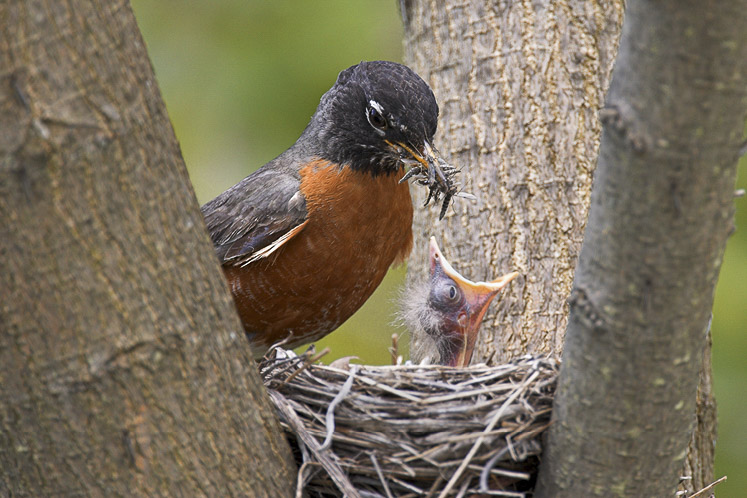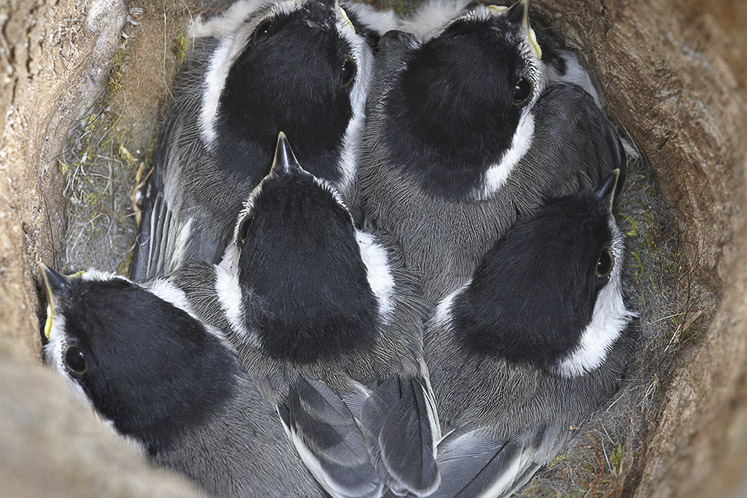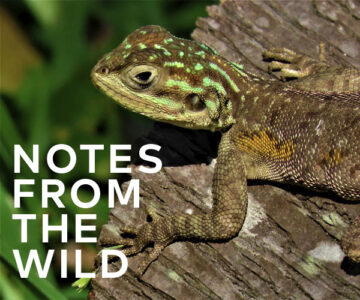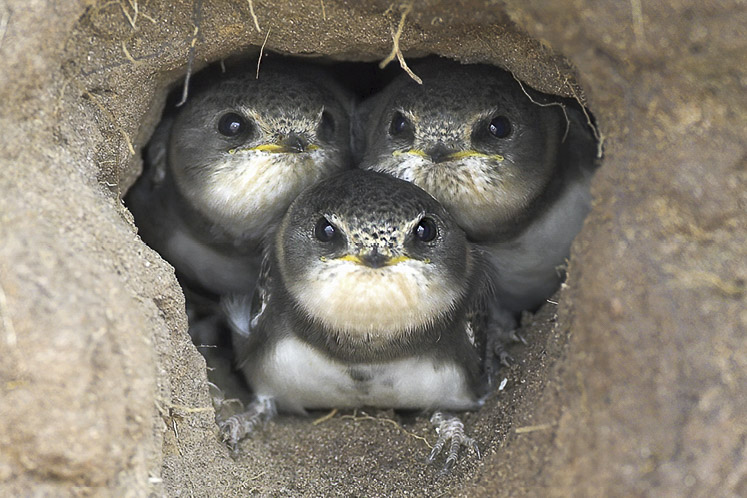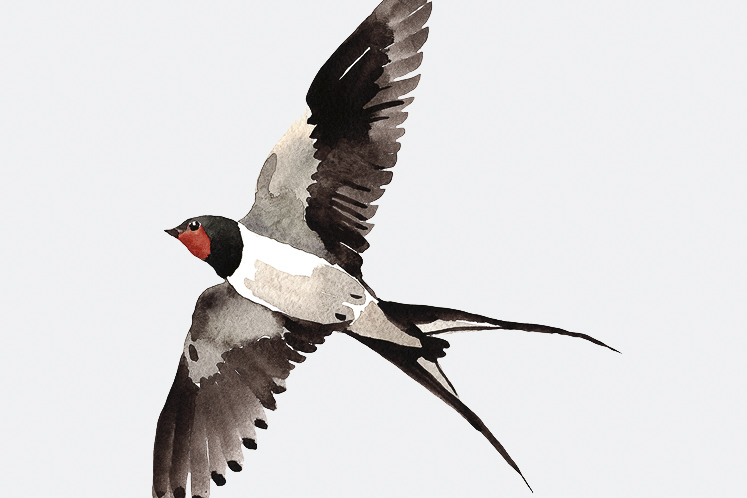Home, Sweet Home
The amazing architectural feats (and sometimes cheeky parenting techniques) of nesting birds
As a boy – with a can of worms in hand – I climbed my neighbour’s apple tree. Straddling a branch, I settled beside a robin’s nest, untangled my worms and dropped them into the wide-open maws of four hungry youngsters.
I had recently read a nature book and yearned to duplicate some of the writer’s delightful experiences with birds. One was feeding baby robins. He had befriended a mother robin who perched on his can of worms and picked them up in her beak to feed her young. This was something I thought was doable, unlike another of the writer’s ventures that involved opening his kitchen window in January, spreading seeds on the table and inviting the birds in.
My attempt at feeding the robin nestlings didn’t go as swimmingly as I’d hoped. Mom and dad robin squawked and fluttered and swooped ominously close to my head. The clamour soon roused my neighbours, who, like the robins, were unimpressed by my attempted beneficence. I clambered down, chastened but unscathed.
But something good did come of that aborted attempt to woo the robins’ affections. I had, for the first time, examined a robin’s nest closely – and marvelled at its sturdy construction of grass and mud. It was, put simply, a work of art.
Consider accepting a challenge to build a bowl-shaped structure that a human could comfortably settle into. For robins, the materials include about 350 sticks and blades of grass, as well as the mud that cements them together. To build the same structure for a person, you might gather a similar number of sticks but substitute long cattail leaves for the grass, and assume that a full bucket of gooey mud is required. Three days might seem like ample time to complete the task – until you realize it’s not a hands-on project. You must build the structure almost exclusively by using your mouth, though if you use your feet to temporarily hold branches in place … well, that’s permissible.
The fact that birds can build nests – intricate, sturdy, structurally sound nests – with their beaks is astonishing. The stunning Baltimore oriole weaves complex pouch-like nests that usually hang from the slender outer branches of trees. Biologist and nature writer Bernd Heinrich believes this positioning is a response to snake predation in the neo-tropical realms where orioles evolved, but in Headwaters, this placement may also thwart predators such as raccoons, opossums and squirrels.
A major component of most oriole nests is the strong fibre found in milkweed stems. Orioles are able to identify dead milkweed stems among the confusion of plant detritus in a spring meadow. One year a female oriole flew into my garden, located the prone stems of the single swamp milkweed I grew and stripped them of their sinuous fibres. She knew exactly what she wanted.

Left: An eastern bluebird brings nesting material to furnish a handy bird box. Right: Orioles weave complex pouch-like nests that hang from outer branches.
Though orioles stick to the same basic design for every nest they build, they’re flexible in their choice of materials. They can assess materials they haven’t encountered before and choose to use them if they meet some innate oriole-nesting standard. Biologist Nancy Flood, who has studied orioles for decades, once found an oriole nest made entirely of fishing line.
Of course, the nests of all birds are not works of art. The diversity of shapes and materials, as well as the sophistication of technique is astonishing. It’s as if Mother Nature invited her avian progeny to a conference and asked them to brainstorm all the ways to build nests, imploring them not to dismiss any idea as too silly or too outlandish.
The birds’ responses? Stick nests, grass nests, mud nests, cavity nests with a dollop of tree sap around the entrance hole, nests containing snakeskins, nests that look like old-fashioned ovens, nests knitted with spider silk, nests using saliva as glue, intricately woven nests, messy nests, nests in trees, nests in thorn bushes, nests on the ground, nests in the ground.
And some birds, stretching Mother Nature’s mandate to the limit, decide to build no nest at all, opting instead to steal nests from their neighbours or, even more slothfully, to slough off their parental responsibilities by laying their eggs in other birds’ nests – and expecting those other birds to raise their young.
The story of one such nest interloper starts on the Great Plains of North America in the 19th century. Early in the 1800s, living waves of bison rumbled across the endless grasslands. As they fed, they flushed out insects such as crickets and grasshoppers, and their bison “patties” attracted clouds of flies and beetles. This bounty of insects attracted insect-eating birds, and one bird species in particular, the brown-headed cowbird, became the bisons’ avian travelling companion. (Perhaps, when considering this time in North American history, we should think of cowbirds as “bisonbirds.”)
Cowbirds are infamous for laying their eggs in the nests of other songbirds and are described, unflatteringly, as “nest parasites.” Ornithologists offer the theory that cowbirds developed this parasitic behaviour because they needed to follow their large, hairy benefactors across the plains and had no time to settle down and raise families. So other birds became the unwitting foster parents of cowbird nestlings.
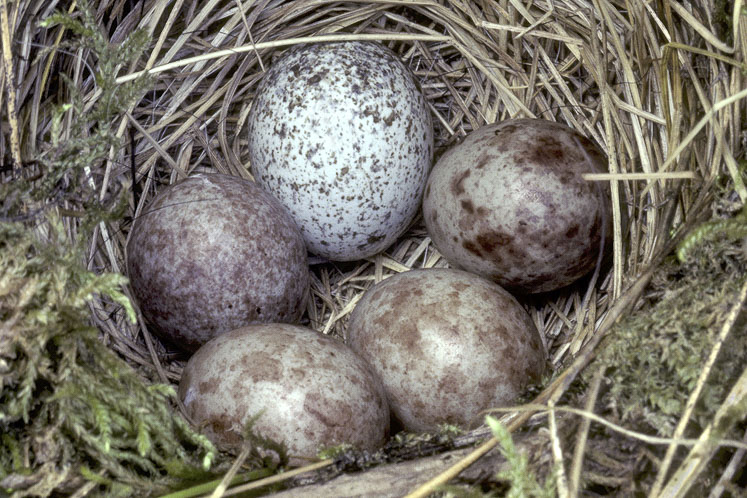
An opportunistic cowbird has laid its egg among the much smaller eggs of a white-throated sparrow who will likely raise the out-sized youngster as its own.
However, as the bison fell to the guns of colonizers, cowbirds shifted their adaptive gaze to bison proxies – the cattle that the new settlers were introducing throughout North America.
Livestock, at least on eastern farms, are stay-at-home animals, but that didn’t change the cowbirds’ nesting behaviour. Evolution takes time, and although most cowbirds no longer roamed with the buffalo, they continued to lay their eggs in the nests of other species.
While some of those species recognize cowbird eggs and push them out or cover them with another nest, most species accept the eggs as their own.
Some songbirds are especially hard hit by the cowbirds’ habits. The Kirtland’s warblers in Michigan, for example, might well be extinct today if not for programs for the trapping and killing of cowbirds – with the result that in 2019 the warblers were removed from the endangered or threatened list.
In Headwaters, the nests of diminutive chipping sparrows are common targets of cowbirds. There is something disturbing – almost monstrous – about watching a haggard adult chipping sparrow dropping food down the throat of a clamouring cowbird fledgling twice its size.
But here, I’m guilty of human bias. Humans are fond of judging the morality of others, and we assess animals through the same critical lens. Cowbirds aren’t morally weak, nor are they malevolent. They are simply following a particularly inventive evolutionary strategy that has served them well for thousands of years.
Still, if we judge cowbirds harshly, we might also tag great horned owls as bullies. These impressive raptors, the unassailable “tyrants” of nocturnal skies, sit atop the avian food chain in Ontario woodlands. Of course, as with cowbirds, judging great horned owls as “tyrants” is silly – but what might prompt that judgment? Great horned owls don’t build nests. Why build a nest when you can simply steal the nest of another bird? Because these owls breed as early as February in Headwaters, it means they’re sitting on those purloined nests long before the “legitimate” tenants begin their own nesting cycles. For the crows, hawks and herons that built the nests the previous season, retreat is the better part of valour. They don’t ask for them back.
Some of the most interesting nesting behaviours can be found among cavity-nesting birds – birds that nest in holes they find or excavate in decaying trees, sandy cliffs, river banks, rock crevices and the like, or in birdhouses we erect for them. Two such species, the tufted titmouse and the Carolina wren, are largely found in the Carolinian zone well south of Headwaters, but they are gradually expanding northward and occasionally wander into these hills.
Like their chickadee kin, tufted titmice line their nests with fur. This isn’t surprising, but their go-to source of fur is. There are amusing videos of devil-may-care titmice landing on sleeping dogs or on the backs of raccoons to pluck their fur.
Carolina wrens, for their part, are noted for building nests in an assortment of human-made objects, including flowerpots and mailboxes. And anyone with a garage in Carolina wren territory may find it prudent to keep the door closed. These bold little birds aren’t afraid to enter a garage and appropriate a handy spare tire or shopping bag as a potential home, or even the pocket of an old coat or snug boot or shoe.
Great-crested flycatchers and red-breasted nuthatches are two cavity-nesting birds common in Headwaters. Small entrance holes keep many predators out, but nest protection can always be enhanced. Great-crested flycatchers, noisy songbirds of moist woodlands, often add a snakeskin to their nests. It’s suggested that a potential nest raider such as a squirrel or blue jay might see the skin and back off, fearing the snake that sloughed it may still be around. It doesn’t matter that no Headwaters snakes are able to climb trees and eat birds or squirrels, the predators don’t know this. A fear of big snakes is likely part of their evolutionary legacy.
Red-breasted nuthatches smear the entrance of their nests with evergreen sap, which may dissuade noxious insects and even small predators from entering. These engaging little birds, frequently seen at bird feeders, have been observed using flakes of bark to apply the sap, earning them membership in the very exclusive club of tool-using birds.
Cavity-nesting birds face stiff competition for a limited supply of accommodation. Woodpeckers are the primary builders. These ecosystem engineers create nesting habitat for themselves and, inadvertently, for a host of other species. Demand for woodpecker-created lodging skyrocketed with the regrettable introduction of starlings and house sparrows from Europe in the 19th century. The next time you see a swirling flock of starlings, know that every one of those myriad birds was raised in a natural or human-made cavity.
Bluebird populations plummeted in response to the competition from the newcomers. Their future appeared bleak but was rescued by a North America-wide effort to install bluebird “trails” consisting of scores or even hundreds of birdhouses in the meadow and hedgerow habitats bluebirds favour. This housing blitz worked. Here in Headwaters, these glorious songbirds are now a common sight along rural roads.
The demand for nesting cavities provides a great opportunity for us to make a difference. At Forks of the Credit Provincial Park, nearly all the 25 bird boxes put up by the Halton/North Peel Naturalist Club are used annually. Club members open each nest box at the end of the breeding season to determine who the occupants were. Nests with a luxurious layer of feathers indicate tree swallows. Boxes full of sticks point to house wrens, and houses packed with a thick layer of grass signal bluebirds. This successful project has also raised an important question. I wonder how many more wrens, bluebirds and tree swallows would fly at the park if more nest boxes were installed? At what point would the demand finally be satiated?

These tree swallow eggs will hatch in a delightfully downy nursery. The tiny eggs are little more than 2 centimetres in length.
Other Headwaters birds have had their nesting success enhanced, not through conscious human effort but by adapting to our buildings and infrastructure. These birds include the swallows and chimney swifts I wrote about in a 2014 issue of this magazine. The high-flying swifts lost much of their nesting habitat – hollow trees – when European settlement swept aside the vast forests that once cloaked the landscape. But a solution was at hand. In a seismic adaptive shift, swifts moved into chimneys.
Their nest construction is unique among Headwaters birds. Swifts’ tiny feet don’t allow them to perch in trees, so they break off small twigs on the fly. They then use their saliva to glue the sticks to the interior of chimneys. Consider how quickly this organic “glue” must dry. Perhaps human engineers should study its composition.
But if humans inadvertently threw chimney swifts a lifeline, we are now reeling it back in. Old, open brick chimneys are disappearing. Having lost hollow trees, chimney swifts are now losing their substitute. Can they once again reinvent their nesting site selection? (Custom-built nesting towers have been tried, but so far unsuccessfully, at least here in Canada.)
Swallows, too, have changed their nesting habits to capitalize on human-created structures and landscape modifications. These days, cliff swallows could now more accurately be called “bridge swallows” – because far more of them now nest, often in dense colonies, under these artificial structures than on cliffs. They also commonly nest in barns and under the roofs of rural porches. Their nests are exquisite gourd-shaped structures, each fashioned with about a thousand dollops of mud.
Barn swallows, of course, are named for their habit of nesting in barns, though they were formerly restricted largely to caves. And bank swallows still tunnel into riverbanks to build their nests but have also benefited from artificially created cliffs at quarry sites like those that pock the Headwaters landscape.
But the nesting needs of all birds go far beyond simply having a suitable place to build a nest. Swallows, for example, will ignore great nesting habitat if food for their young is in short supply. This is why residents of Shelburne, Orangeville or Bolton don’t usually find barn and cliff swallows nesting under their eaves – where there is plenty of nesting habitat, but a dearth of bugs. This is also why the barn swallow nesting structures erected in recent years have had checkered success.
Adequate food, though, is only one essential requirement for nesting birds. Only about a dozen species regularly nest in urban settings. These species include the introduced starlings and house sparrows, as well as natives such as house wrens, chickadees, grackles and, of course, robins.
Although it has been suggested that planting more native trees to support caterpillars and, in turn, feed songbirds, would boost the modest tally of species that nest in towns, this is unlikely. Safety is also essential for successful nesting, and for most Headwaters birds, suburban living is simply too dangerous. Imagine, for comparison, you were considering a move to a neighbourhood where you can raise your family. You find one that offers several grocery stores and a selection of reasonably priced restaurants, so you know feeding your family won’t be a problem. Then you discover that crime in the neighbourhood – vandalism, home invasions, even homicides – is off the charts. Trembling, you look elsewhere.
If you think I’m overstating the danger, consider that no ground-nesting birds choose urban areas. In the rural areas of Headwaters – the farms, the fields, the wetlands and woodlands – more than 40 species nest on or very close to the ground. These include about 15 species of warblers and five species of sparrows. But a glance out your urban window reveals why towns frighten ground-nesting birds: roads, lawns, parking lots and cats.
Still, in the towns and villages of Headwaters, residents can take positive action to support birds. Growing native trees in our yards will help the small number of species that have adapted to urban life, and also feed other species that pause to forage during migration. Conifers in particular can provide the dense nesting habitat some urban birds require to protect them from cats. And speaking of cats, we can keep them indoors – for their safety and the safety of urban wildlife. We can also advocate for the rewilding of portions of urban parks, replacing some of the turf with meadows, shrubs and trees.
Beyond our towns, we can manage Headwaters conservation areas and provincial parks to maximize habitat diversity. Planting trees is sometimes the answer, but removing trees is also sometimes necessary, as has been done at Forks of the Credit Provincial Park to preserve valuable meadow habitat where at-risk bobolinks and meadowlarks nest. And we can put up bird boxes just about everywhere: in towns for chickadees and house wrens, and in rural areas for bluebirds and tree swallows. And on a much larger scale, we need to protect the Greenbelt.
The breeding birds of these hills are nurtured by Headwaters’ diverse habitats, habitats that offer not only food and security, but also scope for the wondrous engineering of their nests.
More Info
Nest Superlatives
Smallest Ontario nest
Ruby-throated hummingbird. The exquisite nests of these smallest of Ontario birds are about 5 centimetres wide and about 2.5 centimetres deep. The nests are carefully wrought cups of thistle or dandelion down held together by spider webs and camouflaged by lichen.
Largest Ontario nest
Bald eagle. These majestic birds build huge stick nests. A bald eagle nest in Florida holds the world record for largest bird nest. It was nearly 3 metres in diameter, 6 metres deep and weighed more than 2 tonnes!
Number of eggs in a wood duck nest
A single female wood duck (common residents of Headwaters) can lay about 15 eggs, but they will also sometimes “dump” their eggs into another wood duck’s nest, bringing the total to 40 or so!
Number of eggs a female cowbird can lay in nests of other birds
Eighty or more – in a single season.
“Five Ways of Looking at Birds”
Glance out the window
as chickadees grab and go
from a half-full feeder
Scan bare branches
for the source
of that sweet piercing note
Study LBJs* in the garden
who flit off and on
seed-heavy flowerheads
Squint into the sky
to track raptors
who cast fast shadows
Notice flapping herons
heading home slowly
to their heronry
—Poem by Carol Good
*Little brown jobs, a term of endearment for small, dark, unidentified birds.
Inspired by Wallace Stevens’ “Thirteen Ways of Looking at a Blackbird.”
Read more about Carol Good in our Over the Next Hill department, which spotlights inspiring senior citizens making a difference in our communities.
Related Stories
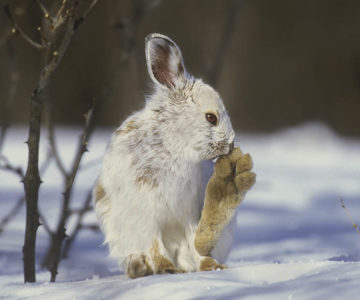
In the Bleak Midwinter
Nov 20, 2022 | | EnvironmentDon Scallen explores how birds, mammals and reptiles have adapted to survive our long, trying winter.
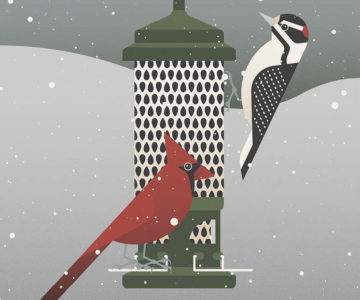
Feed the Birds
Nov 20, 2022 | | Country Living 101Looking to bring colour and joy to those grey winter days? Setting up a feeder for our fine feathered friends is a mutually beneficial move.

